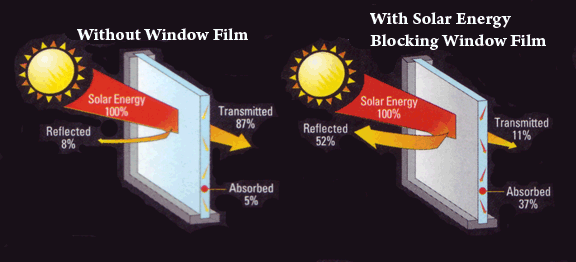
Does Window Tinting Really Reduce Energy Bills? The Facts for North Alabama Homes and Businesses
For homeowners and business owners in North Alabama, the cost of keeping interiors cool during the summer can be brutal. It’s no surprise many people turn to window tinting as a potential solution. But does it actually work? Can a simple film on your glass really reduce your energy bills?
The answer is yes — but not all tints are created equal, and the savings depend on factors like tint type, window orientation, building structure, and local climate. This article breaks down the science and economics of energy-saving window tinting for homes, offices, and storefronts in Florence, Muscle Shoals, and beyond.
How Window Tinting Affects Energy Use
At its core, window film reduces energy consumption by limiting the amount of solar heat gain that passes through your glass. In the summer, untreated windows act like magnifying glasses — absorbing and transmitting heat into your space. That forces your HVAC system to work harder and longer, especially during peak hours.
Window films reduce this effect by:
- Reflecting or absorbing infrared (IR) light, which carries heat
- Blocking ultraviolet (UV) rays, which not only heat but also damage furnishings
- Reducing glare, allowing for natural lighting without heat gain
Together, these factors help stabilize indoor temperatures — which reduces how often your A/C unit kicks on.
Real-World Energy Savings: What the Data Says
According to the International Window Film Association (IWFA), professionally installed residential window films can reduce cooling costs by up to 30% in warm climates like Alabama. Commercial buildings — with larger surface area and often older glass — can see 15–25% reductions on average.
Let’s put that into local perspective:
Example: 2,000 sq. ft. Home in Florence, AL
- Average monthly summer utility bill: $280
- Cooling-related portion: ~60% = $168
- Estimated savings with high-performance tint: 20–30% of cooling = $33 to $50/month
- Annual summer-season savings: $150 to $250
The numbers get larger when scaled across entire office buildings or retail spaces, especially those with west- and south-facing glass walls.
📄 Source: IWFA Energy Savings Research
Which Types of Window Tint Save the Most Energy?
Not every tint film offers energy benefits. Decorative or purely privacy films may look great, but contribute little to thermal performance.
1. Spectrally Selective Films
- Engineered to block IR and UV light while allowing in visible light
- Ideal for residential settings where you want daylight without heat
- Reduces heat gain without darkening the interior
2. Metallic/Reflective Films
- Reflective appearance, like a mirror from the outside
- Excellent at blocking solar radiation (including IR)
- Most common in commercial applications and office glass
- Can interfere with cell service and Wi-Fi if not properly chosen
3. Ceramic Films
- Non-metallic and non-dyed
- Offers high clarity with strong heat rejection
- Great balance for homes or front-facing businesses
- Costlier than dyed films, but more durable and effective
Each type of film includes a Solar Heat Gain Coefficient (SHGC) — the lower the SHGC, the better the tint is at keeping heat out.
Where Tint Delivers the Highest ROI
To get the best bang for your buck, prioritize tinting:
- South- and west-facing windows — these get the most intense afternoon sun.
- Large panes or sliding glass doors — more surface area means more energy loss.
- Rooms with electronics or HVAC strain — like media rooms or sunrooms.
You don’t need to tint every window. Strategic placement can offer major benefits without breaking the bank.
Does Window Tint Help in Winter?
Here in North Alabama, summers are the primary energy burden — but winter efficiency still matters.
Most modern energy-efficient films also:
- Reduce heat loss through windows by improving thermal insulation
- Block drafts or cold spots near large panes
- Reflect indoor heat back into the room
While the savings in winter are smaller (especially in southern climates), tint still helps reduce workload on electric or gas heating systems.
Window Tinting vs. Window Replacement
Homeowners often ask: Should I just replace my windows instead?
Window Tinting:
- ~$6 to $12 per square foot installed
- ROI often within 2–3 years
- Minimal disruption (no construction)
- Works with most existing windows
New Windows:
- $500–$1,000+ per window installed
- ROI can take 10+ years
- May be necessary for broken seals or structural issues
For energy savings alone, tinting is the clear winner in terms of speed and cost-effectiveness — especially if your glass is in good shape.
Local Case Study: Florence Retail Office (Before & After)
A small accounting office on Wood Avenue installed high-performance ceramic tint on all front and west-facing windows (about 250 sq. ft. total).
Before:
- Interior temps spiked to 82°F by 2 PM
- Monthly summer power bill: ~$410
After:
- Office stays under 74°F all afternoon
- Power bill dropped to ~$305 (26% savings)
- Staff noticed reduced glare and fewer A/C cycles
Total install cost: $2,200
Estimated payback period: < 2 years
Other Benefits Beyond Energy Savings
While this article focuses on efficiency, window tint also delivers:
- UV Protection: Blocks up to 99% of UV rays, reducing furniture, flooring, and artwork fading
- Glare Reduction: Reduces eye strain and screen reflection in offices
- Privacy: Certain films obscure vision from the outside without reducing daylight
- Glass Strength: Some films add a layer of shatter resistance
The Bottom Line: Yes, Tinting Saves Energy — If You Do It Right
If you live in Florence, Muscle Shoals, or anywhere in North Alabama, tinting your windows is a smart move — especially with our long, sun-intense summers. The right film, installed on the right windows, can:
- Lower your A/C bills by 15–30%
- Improve comfort and privacy
- Extend the life of furniture and electronics
But like any upgrade, the results depend on quality materials and professional installation. Cheap films from a big-box store won’t deliver the same savings — or last nearly as long.
North Alabama Service Pros connects you with licensed local installers who specialize in energy-efficient window tinting for homes, offices, and commercial spaces. We’ll help you choose the right film for your goals — and ensure it’s installed to code. Want more information on how we can help you with your window tinting needs? CLICK HERE. Want to get started on a quote right now? Fill out the form below.
